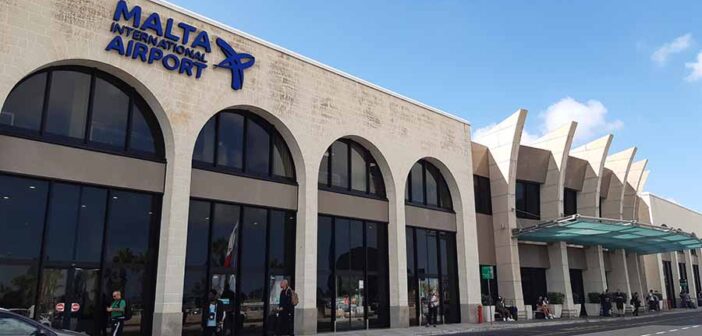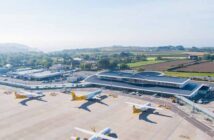Malta International Airport, located 5 kilometres southwest of Valletta in Luqa, serves as the sole gateway to the Maltese Islands, handling nearly 9 million passengers in 2024. As a hub for KM Malta Airlines and a base for Ryanair, it connects to over 100 destinations across 35 countries, including London, Rome, and Istanbul, with carriers like easyJet, BA, and Emirates. Its compact design and modern amenities ensure a practical experience for travellers exploring Malta or connecting to Europe and beyond.
Accessing the airport is straightforward, with convenient transport options linking to Valletta and other towns. Four express bus routes (X1, X2, X3, X4) connect to Valletta, Sliema, St. Julian’s, and Cirkewwa for Gozo ferries, taking 20 to 45 minutes with fares from €2, purchasable via the Tallinja app or at the Welcomers’ Hall ticket office, open 8:00 am to 7:30 pm.
Taxis, available 24/7 at the arrivals hall, cost €22 to St. Julian’s and €30 to Bugibba, with pre-booked options via the Malta Taxi app. Drivers can reach the airport via the A3, with Park East multi-storey and SkyParks car parks offering 10 minutes of free parking, then €2 per hour or €15 daily. Car rental agencies like Avis and Hertz are located in Park East, a short walk from the terminal. Traffic around urban areas like Sliema can slow transfers during rush hours (6:30–8:30 am, 4:30–6:30 pm), so extra time is advised.
The airport’s single terminal, operational since 1992, spans three floors and handles both Schengen and non-Schengen flights. The ground floor houses check-in desks and arrivals, the first floor manages departures and security, and the second floor hosts additional seating. With 29 gates (18 on the ground floor, 11 upstairs), the compact layout ensures walks under 10 minutes, with clear signage in English and Maltese.
Security typically takes 10 to 15 minutes, but peak summer periods can see 20-minute queues due to high passenger volumes or staffing shortages, as noted on X. Fast Track lanes, from €10, expedite the process. Travellers should arrive two hours early for flights to account for potential congestion.
Dining and retail options are diverse, catering to a range of tastes. Airside, passengers can enjoy Maltese cuisine at Hard Rock Cafe, quick bites at Costa Coffee, or sandwiches at Dr. Juice. Landside, a café in the Welcomers’ Hall serves snacks. Family-friendly menus are available, though prices are higher than in Valletta. Retail includes Aelia Duty Free for cosmetics and local souvenirs, Agenda Bookshop for reading materials, and Classic Jewellers for accessories. Samsonite and 8 Till Late provide travel essentials. The 24/7 duty-free shop and bookshop ensure round-the-clock access, but budget travellers may prefer city shops for better value.
Facilities are modern, with free unlimited Wi-Fi via the “MIA Wifi” network, charging stations, and potable water fountains. Accessibility is prioritised, with lifts, T-loop systems, a sensory room, and free assistance for passengers with reduced mobility, bookable 48 hours in advance. Family amenities include a parent room and priority seating. The La Valette Club Lounge, accessible for €40 or €30 for members, offers snacks, drinks, and an outdoor area, though food variety can be limited, per Flightradar24 reviews. A pharmacy, medical centre, chapel, and baggage services (wrapping at €10, storage at €5 for 12 hours) are available. Seating can be scarce during peak times, and sleeping in the terminal is discouraged.
On-time performance is generally strong, with an average delay of 15 minutes for departures, per recent data. Weather, particularly fog, or air traffic control issues across Europe can cause disruptions, as can Ryanair’s tight schedules, according to Flightradar24. The night curfew (11:00 pm–6:00 am) may divert late flights. Passengers should check statuses via the airport’s website, Aena app, or Flightradar24.
Connections are seamless due to the single terminal, with minimum connection times of 45 minutes for Schengen-to-Schengen and 60 minutes for non-Schengen transfers. Passengers on separate tickets may need to reclaim luggage and recheck-in, requiring up to two hours, especially for non-Schengen arrivals facing 30-minute immigration queues. Budget airline travellers should plan longer layovers, as assistance for missed connections is limited.
Potential delays often stem from weather, staffing shortages, or baggage handling issues during peak tourist seasons. Passport control for non-Schengen flights can slow down, with X users reporting understaffed counters. Travellers should monitor gate assignments, as some require a 10-minute walk, and pre-book transport to avoid taxi wait times during high season.




